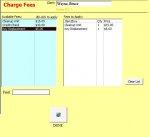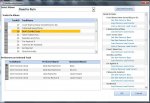All,
Again, many thanks for this website. It is really helpful.
I managed to make my previous sticking point work (after some trial and error) but now I am REALLY stuck! :banghead:
The database has been working as I intended but I keep wanting to add new features. This is a music collection database. I am using it to track items such as Albums, Songs, Composers, Tracks on Albums, Artists on Tracks, Artists on Albums and so on. All that works well.
However, I would like to add Performers on Tracks (i.e. who played Guitar etc). I can figure out how to do this add at overall Album level but at Track level it requires some more work to avoid excessive data entry.
Essentially we have the following as part of the structure:
tblTracks
TrackID (PK)
AlbumID (FK)
TrackName
...
tblPerformer
PerformerID (PK)
PerformerName
tblInstrument
InstrumentID (PK)
InstrumentName
jtblPlayedOn
TrackID (FK)
PerformerID (FK)
InstrumentID (FK)
Where I am stuck is in deciding what is the best way to set up data entry for the Junction Table. Ideally I would like a form that would allow the user to select an album and show the tracks for that album. They could be selected individually or multiple (e.g. all tracks on an album if desired) and allow the Performer ID and Instrument ID to be entered.
I have been looking to Append Queries and using some sort of multi-select Listbox but it is all confusing to this novice.
Any advice greatly appreciated!
Again, many thanks for this website. It is really helpful.
I managed to make my previous sticking point work (after some trial and error) but now I am REALLY stuck! :banghead:
The database has been working as I intended but I keep wanting to add new features. This is a music collection database. I am using it to track items such as Albums, Songs, Composers, Tracks on Albums, Artists on Tracks, Artists on Albums and so on. All that works well.
However, I would like to add Performers on Tracks (i.e. who played Guitar etc). I can figure out how to do this add at overall Album level but at Track level it requires some more work to avoid excessive data entry.
Essentially we have the following as part of the structure:
tblTracks
TrackID (PK)
AlbumID (FK)
TrackName
...
tblPerformer
PerformerID (PK)
PerformerName
tblInstrument
InstrumentID (PK)
InstrumentName
jtblPlayedOn
TrackID (FK)
PerformerID (FK)
InstrumentID (FK)
Where I am stuck is in deciding what is the best way to set up data entry for the Junction Table. Ideally I would like a form that would allow the user to select an album and show the tracks for that album. They could be selected individually or multiple (e.g. all tracks on an album if desired) and allow the Performer ID and Instrument ID to be entered.
I have been looking to Append Queries and using some sort of multi-select Listbox but it is all confusing to this novice.
Any advice greatly appreciated!





